What’s the architecture like in Chapala and Ajijic, Mexico?
Santiago Hernandez - Chapala Med
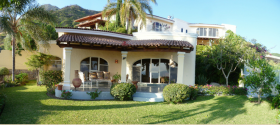 The architecture in Chapala and Ajijic is very traditional Mexican. Once you cross to the border towns you will find that the houses are very traditional. The houses here are no more than one or two stories and are flat and very box-like. I am not an architect so I don’t know the exact terms to describe it but the architecture here is definitely not German-looking where the houses have the peaks on top. The roofs of the houses here in Chapala and Ajijic tend to be flat. If you...
The architecture in Chapala and Ajijic is very traditional Mexican. Once you cross to the border towns you will find that the houses are very traditional. The houses here are no more than one or two stories and are flat and very box-like. I am not an architect so I don’t know the exact terms to describe it but the architecture here is definitely not German-looking where the houses have the peaks on top. The roofs of the houses here in Chapala and Ajijic tend to be flat. If you... The architecture in Chapala and Ajijic is very traditional Mexican. Once you cross to the border towns you will find that the houses are very traditional. The houses here are no more than one or two stories and are flat and very box-like. I am not an architect so I don’t know the exact terms to describe it but the architecture here is definitely not German-looking where the houses have the peaks on top. The roofs of the houses here in Chapala and Ajijic tend to be flat. If you travel up into the part of Ajijic that is up on the mountains, you will see houses that tend to be of very modern designs.
The architecture in Chapala and Ajijic is very traditional Mexican. Once you cross to the border towns you will find that the houses are very traditional. The houses here are no more than one or two stories and are flat and very box-like. I am not an architect so I don’t know the exact terms to describe it but the architecture here is definitely not German-looking where the houses have the peaks on top. The roofs of the houses here in Chapala and Ajijic tend to be flat. If you travel up into the part of Ajijic that is up on the mountains, you will see houses that tend to be of very modern designs.From what I’ve seen, they try to maintain the outside integrity of homes here. Anesthetically, it looks very Mexican and traditional but when you go inside, you will see that they have all the modern conveniences. You would see some houses that have very bright Mexican colors like bright orange, blue, etc. and the architecture is very traditional but when you walk inside, you will see very nice, modern, and upscale furnishings. Even the new developments still build in the traditional, Mexican style.
(House in Lake Chapala, Mexico, pictured.)
Posted February 5, 2016
Steve Cross - Luxury Homes Ajijic
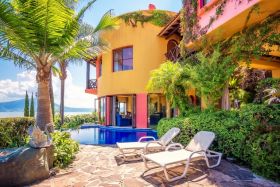 The Ajijic area where many expats have chosen to make their home, features a variety of home styles. Right in the village you will find many homes of traditional Mexican style right beside others that have had a total remodel to a more modern flavor.
The Ajijic area where many expats have chosen to make their home, features a variety of home styles. Right in the village you will find many homes of traditional Mexican style right beside others that have had a total remodel to a more modern flavor. Most gated communities feature a modern, one level style on a good sized lot, usually with between two or three bedrooms and some will have a common shared pool and others will have a private pool.
...  The Ajijic area where many expats have chosen to make their home, features a variety of home styles. Right in the village you will find many homes of traditional Mexican style right beside others that have had a total remodel to a more modern flavor.
The Ajijic area where many expats have chosen to make their home, features a variety of home styles. Right in the village you will find many homes of traditional Mexican style right beside others that have had a total remodel to a more modern flavor. Most gated communities feature a modern, one level style on a good sized lot, usually with between two or three bedrooms and some will have a common shared pool and others will have a private pool.
Views of the lake are often a popular request and of course for that it's either lakefront (these properties are usually an older Mexican style) or up in the hills in and around the village and there you will find a mix of architecture.
Some high end homes such as Le Grand Paradisio (pictured) combine both a Mexican modern feel mixed with some traditional elements.
Posted May 17, 2016
Anne Dyer - Casita Montana
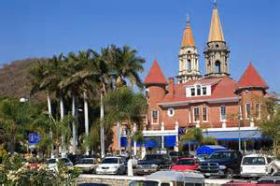 In the actual village of Ajijic, where I live, there are stores and buildings that are painted in different colors with murals painted on them. The houses vary from Mexican style to more of a California look. We have a lot of California or Arizona type of architecture with buildings that have flat roofs.
In the actual village of Ajijic, where I live, there are stores and buildings that are painted in different colors with murals painted on them. The houses vary from Mexican style to more of a California look. We have a lot of California or Arizona type of architecture with buildings that have flat roofs. Most people that are active in their social life are more likely to live in Ajijic than in Chapala. Chapala is more noted for the Mexican people who come...
 In the actual village of Ajijic, where I live, there are stores and buildings that are painted in different colors with murals painted on them. The houses vary from Mexican style to more of a California look. We have a lot of California or Arizona type of architecture with buildings that have flat roofs.
In the actual village of Ajijic, where I live, there are stores and buildings that are painted in different colors with murals painted on them. The houses vary from Mexican style to more of a California look. We have a lot of California or Arizona type of architecture with buildings that have flat roofs. Most people that are active in their social life are more likely to live in Ajijic than in Chapala. Chapala is more noted for the Mexican people who come in for the weekend. There are also lots of Americans who live in Chapala and there are a lot of old colonial houses here.
We have the old Braniff Airlines house here. There is a nice history about the whole area from a guy from Holland who came in and put the first railroad in and so there is an old train station here in Chapala. Traveling by train was the mode of transportation before the cars became popular. There is a lot of history in Chapala.
(Braniff Airlines house, Chapala, Mexico, pictured.)
Posted August 6, 2016
Amaranta Santos - Eager y Asociados
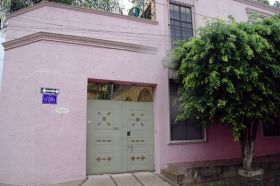 The architecture in Chapala and Ajijic differs depending on when a certain construction was made. This area started as a fishing village so you could still find adobe constructions here. Not that you would want to buy one, but you can certainly find one. You can also find the regular colonial buildings, which are stucco and brick. You will also find a lot of things that were built in the 1970s.
The architecture in Chapala and Ajijic differs depending on when a certain construction was made. This area started as a fishing village so you could still find adobe constructions here. Not that you would want to buy one, but you can certainly find one. You can also find the regular colonial buildings, which are stucco and brick. You will also find a lot of things that were built in the 1970s. One good example of that would be in La Floresta. As the...
 The architecture in Chapala and Ajijic differs depending on when a certain construction was made. This area started as a fishing village so you could still find adobe constructions here. Not that you would want to buy one, but you can certainly find one. You can also find the regular colonial buildings, which are stucco and brick. You will also find a lot of things that were built in the 1970s.
The architecture in Chapala and Ajijic differs depending on when a certain construction was made. This area started as a fishing village so you could still find adobe constructions here. Not that you would want to buy one, but you can certainly find one. You can also find the regular colonial buildings, which are stucco and brick. You will also find a lot of things that were built in the 1970s. One good example of that would be in La Floresta. As the village started developing towards the west, you would find things that were built in the 80s. There are a few condos there that are 80s style. Then there was a boom in the 1990s and built things in the style of Frank Lloyd Wright. So the types of architecture here in Chapala and Ajijic vary between minimalistic to classical-colonial, American style, etc. However, most of the things that are already built have a Mexican sense to them, either in the arches or in the copulas, or the boveda ceilings since these things tend to make the temperature much better.
When you walk through the streets here in Ajijic, you would probably see a lot of walls and you would have no idea what’s going on behind those walls. There actually tours here in Ajijic that are called “Behind Walls.” If you trust just yourself and just check out the types of architecture here you won’t probably be able to see much because this is a place where you really need to go through that street wall in order to see what’s going on behind it. Since the streets and sidewalks in Ajijic are small and narrow, people need to get their privacy by building high walls right up against the sidewalk. If you want to see architecture, you have to ask your friends to show you their houses or you could meet with a real estate agent who could show you the houses from the inside in order to be able to have a clear idea of what you want to buy.
There are gated communities and developments that are a little bit more conspicuous and you would see more of what’s going on with the architecture just by standing on the outside. In Mision de Lago, for example, you could pretty much see what’s going on inside there because as a development, instead of a big wall, they have condos on the outside and you could see the construction, more or less. To really have a real feel of what’s going on here, you would need somebody to lead you into the real deal and open the doors for you.
(High walls of a house in Ajijic village, Mexico, pictured.)
Posted September 12, 2016
Alicia Gomez - Collins Real Estate
 The most common architecture here in Chapala and Ajijic is colonial architecture. Most houses have boveda ceilings, which is very popular here. It is an arched area in the house. Many times they are around 3 and a half feet wide, then there are I-beams with bricks spanning them in an arched formation. Bovedas are extremely common here, even in the poor houses. Many people like it because it is nice to look at. It is beautiful.
The most common architecture here in Chapala and Ajijic is colonial architecture. Most houses have boveda ceilings, which is very popular here. It is an arched area in the house. Many times they are around 3 and a half feet wide, then there are I-beams with bricks spanning them in an arched formation. Bovedas are extremely common here, even in the poor houses. Many people like it because it is nice to look at. It is beautiful. Architects are usually not...
 The most common architecture here in Chapala and Ajijic is colonial architecture. Most houses have boveda ceilings, which is very popular here. It is an arched area in the house. Many times they are around 3 and a half feet wide, then there are I-beams with bricks spanning them in an arched formation. Bovedas are extremely common here, even in the poor houses. Many people like it because it is nice to look at. It is beautiful.
The most common architecture here in Chapala and Ajijic is colonial architecture. Most houses have boveda ceilings, which is very popular here. It is an arched area in the house. Many times they are around 3 and a half feet wide, then there are I-beams with bricks spanning them in an arched formation. Bovedas are extremely common here, even in the poor houses. Many people like it because it is nice to look at. It is beautiful. Architects are usually not involved in making these beautiful bovedas. I used to work for Notary Public Number 2 for 8 years. When you first come in to the office, the first thing you would see are the boveda ceilings. I love it. It is one of the best ones I have even seen, and I’ve seen a lot. You will be amazed at the job that they did on these bovedas on every corner. A local who has been building houses all his life made that boveda. He is not even an architect.
You will also see fancy homes with modern architecture, and in general, you could find different kinds of architecture in Chapala and Ajijic. If you are going to build a house here, you could build whatever kind of architecture you like. There are lots of architects here that can help you with that. They make buildings of great quality for a good price.
(Brick and bowed boveda ceiling, Lake Chapala, Mexico, pictured.)
Posted October 7, 2016
Magy Carmona - Magy Carmona at Lake Chapala Realty
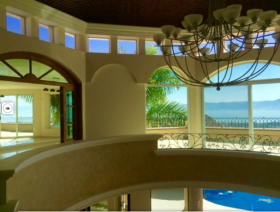 The architecture in Chapala and Ajijic is colonial-style. Chapala used to be a very nice vacation place in the 30’s or 40’s for posh people, until the lake started to dry out. (It’s no longer dry.)
The architecture in Chapala and Ajijic is colonial-style. Chapala used to be a very nice vacation place in the 30’s or 40’s for posh people, until the lake started to dry out. (It’s no longer dry.) In Ajijic and in Chapala, you’ll usually see bricks, cobblestones, bovedas, balconies, fountains, and cantera stone. It’s like a stereotype of a Mexican town that many people have because of the movies. But the movies do...
 The architecture in Chapala and Ajijic is colonial-style. Chapala used to be a very nice vacation place in the 30’s or 40’s for posh people, until the lake started to dry out. (It’s no longer dry.)
The architecture in Chapala and Ajijic is colonial-style. Chapala used to be a very nice vacation place in the 30’s or 40’s for posh people, until the lake started to dry out. (It’s no longer dry.) In Ajijic and in Chapala, you’ll usually see bricks, cobblestones, bovedas, balconies, fountains, and cantera stone. It’s like a stereotype of a Mexican town that many people have because of the movies. But the movies do not always depict the truth, while Chapala and Ajijic area are really beautiful towns.
You’ll also find modern architecture in Chapala and Ajijic because people keep on building. There are some fraccionamientos (housing developments) that may be 30 years old but are constantly being renovated. People live in Ajijic for around 10 -15 years and then move, so the houses are always sold, refurbished and renewed. That’s why today, the typical or traditional way of architecture in Chapala and Ajijic is blending in with new styles. There are also other beautiful places like La Floresta, which looks like California in the 1960’s or 1970’s.
(Double-height domed ceiling, Ajijic, Mexico, pictured.)
Posted November 22, 2016
Joan Silver
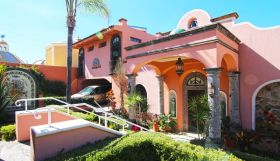 Chapala and Ajijic are simple fishing villages and so for the most part, the architecture is simple and often walled. Chapala has some colonial style architecture as well. Jalisco (the state that Chapala and Ajijic is in and that also contains Guadalajara) also has architecture that makes the state unique that are the cupolas (a small dome adorning a roof or ceiling). Cupolas are wonderful to vent out hot air and bring in the cool breeze and can be anything from very simple plastered...
Chapala and Ajijic are simple fishing villages and so for the most part, the architecture is simple and often walled. Chapala has some colonial style architecture as well. Jalisco (the state that Chapala and Ajijic is in and that also contains Guadalajara) also has architecture that makes the state unique that are the cupolas (a small dome adorning a roof or ceiling). Cupolas are wonderful to vent out hot air and bring in the cool breeze and can be anything from very simple plastered... Chapala and Ajijic are simple fishing villages and so for the most part, the architecture is simple and often walled. Chapala has some colonial style architecture as well. Jalisco (the state that Chapala and Ajijic is in and that also contains Guadalajara) also has architecture that makes the state unique that are the cupolas (a small dome adorning a roof or ceiling). Cupolas are wonderful to vent out hot air and bring in the cool breeze and can be anything from very simple plastered structures to beautifully tiled ones. You can see fabulous photos of cupolas on very simple homes with wooden doors.
Chapala and Ajijic are simple fishing villages and so for the most part, the architecture is simple and often walled. Chapala has some colonial style architecture as well. Jalisco (the state that Chapala and Ajijic is in and that also contains Guadalajara) also has architecture that makes the state unique that are the cupolas (a small dome adorning a roof or ceiling). Cupolas are wonderful to vent out hot air and bring in the cool breeze and can be anything from very simple plastered structures to beautifully tiled ones. You can see fabulous photos of cupolas on very simple homes with wooden doors. Arched entryways are popular in Chapala and Ajijic. There are dome ceilings with recessed lighting and bovedas (arched brick ceilings) that are a real marvel. Bricked ceilings are truly something to see made. Nobody ever thought that brick ceilings would be attractive. We do no need to plaster or paint them because they're absolutely beautiful.
(Home with arched entry way, Ajijic, Mexico, pictured.)
Posted December 31, 2016
Jeff Smith - DocTours
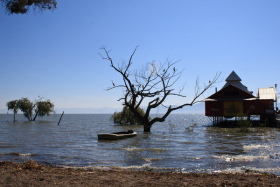 Even though the Lake Chapala / Ajijic area is not that big, the architecture you will see still depends on the area of town. Most of the structures are not much to look at. Some have nice paint jobs which brighten their appearance.
Even though the Lake Chapala / Ajijic area is not that big, the architecture you will see still depends on the area of town. Most of the structures are not much to look at. Some have nice paint jobs which brighten their appearance. For some real eye candy, stroll any of the upscale neighborhoods. Many are surrounded by walls, which is part of the Latin look (a style dating back to the Roman Empire). The houses you can see look quite appealing -- long...
 Even though the Lake Chapala / Ajijic area is not that big, the architecture you will see still depends on the area of town. Most of the structures are not much to look at. Some have nice paint jobs which brighten their appearance.
Even though the Lake Chapala / Ajijic area is not that big, the architecture you will see still depends on the area of town. Most of the structures are not much to look at. Some have nice paint jobs which brighten their appearance. For some real eye candy, stroll any of the upscale neighborhoods. Many are surrounded by walls, which is part of the Latin look (a style dating back to the Roman Empire). The houses you can see look quite appealing -- long lines, gentle curves, flat roofs with lookouts (miradors). The landscaping is colorful and attentive to detail. I've found many favorites I'd be happy to live in forever.
(Boathouse in Ajijic,Mexico, pictured.)
Posted February 13, 2017



.png)